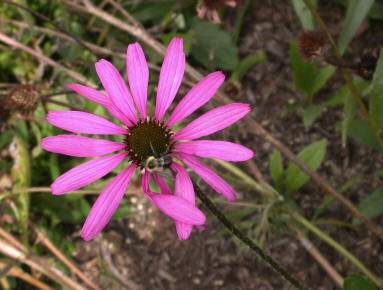Faith Peterson
Adams County Master Gardener

(8/8) With so much focus on the decline of several bee species and other pollinators, including our beautiful Monarch butterfly, many gardeners and nature enthusiasts are wondering what they can do. You may ask how you, here in Adams County, can use your landscape to provide a haven for native animals, insects and birds.
There are many websites and organizations that can provide some answers. For example, the PA Native Plant Society website has complete info on native plant sources, plant information and landscaping, as well as events. Here in Adams and York Counties, our Penn State Master Gardeners have fact sheets, plant lists, and demonstration gardens available
to all with a phone call, visit or email.
Residential properties play an important role in wildlife conservation. When considering planting a tree on your property, please plan to plant a native tree that will help sustain and nourish our native insects. Remember, insects are the diet mainstay for all young birds, as well as toads, frogs, and small mammals, filling that all important role
near the bottom of the food chain. When planting a tree, remember to consider its eventual height and width, and exposure and water needs.
A study in suburban Chicago recently reported that ‘having neighborhoods with many wildlife-friendly yards is more important than having a neighborhood surrounded by parks or forest preserves.’ Residential areas with a variety of tree species attract twice as many bird species as neighborhoods lacking that variety.
 Doug Tallamy, a University of Delaware entomologist says ‘96% of all terrestrial birds raise their offspring on insects, primarily caterpillars.’ Native oak trees host 557 caterpillar species. Tallamy says ‘The more caterpillars a yard produces, the greater the chances a bird will nest
successfully.’
Doug Tallamy, a University of Delaware entomologist says ‘96% of all terrestrial birds raise their offspring on insects, primarily caterpillars.’ Native oak trees host 557 caterpillar species. Tallamy says ‘The more caterpillars a yard produces, the greater the chances a bird will nest
successfully.’
Two years ago, Tallamy, in partnership with the National Wildlife Federation and the U. S. Forest Service, began a study of plant preference of every butterfly and moth in the U.S. Part of the project is the development of an online database listing wildlife friendly plants for each of the nation’s 3,000 counties. The database will allow gardeners,
educators and others to search for native plants by their zip code.
Here is how to access the National Wildlife Federation’s website: nwf.org/nativeplants-beta/plants/bylocale. That brings up a ‘Native Plants by Zip Code – NWF’ site. The site will feature a tab ‘About’. This tab explains how to use this tool, breaking down results into two categories: flowers and grasses, and trees and shrubs. I must caution that
the site is still being worked on, and not all of the information is complete at this time. The plants are ranked by the number of caterpillar species they support. You can click on any plant to learn more about it.
Under the ‘Find Butterflies’ tab, there will be a list of butterflies and moths in your area, and what host plants their caterpillars depend on. As I perused this site, it is obvious that it is a work in progress. You may not find some of the things you are looking for right away. I am hoping that over the rest of 2016 that a lot of the site work
can be completed, so that it will be ready for planning our 2017 gardens and landscape plans.
The ‘Choosing Plants’ tab gives you information on selecting the right plant for the right spot. It also highlights the importance of trees to your landscape and the community at large. Under ‘Supplier’ tab, there are directions to locate native plant nursery directories in each state.
I am so happy with this new website, and appreciate all the time and research spent on developing it so far. As a Master Gardener, I look forward to recommending this website to my gardening friends and neighbors. Happy Gardening with Native Plants!
Read other articles on birds, wildlife & beneficial insects
Read other articles by Faith Peterson